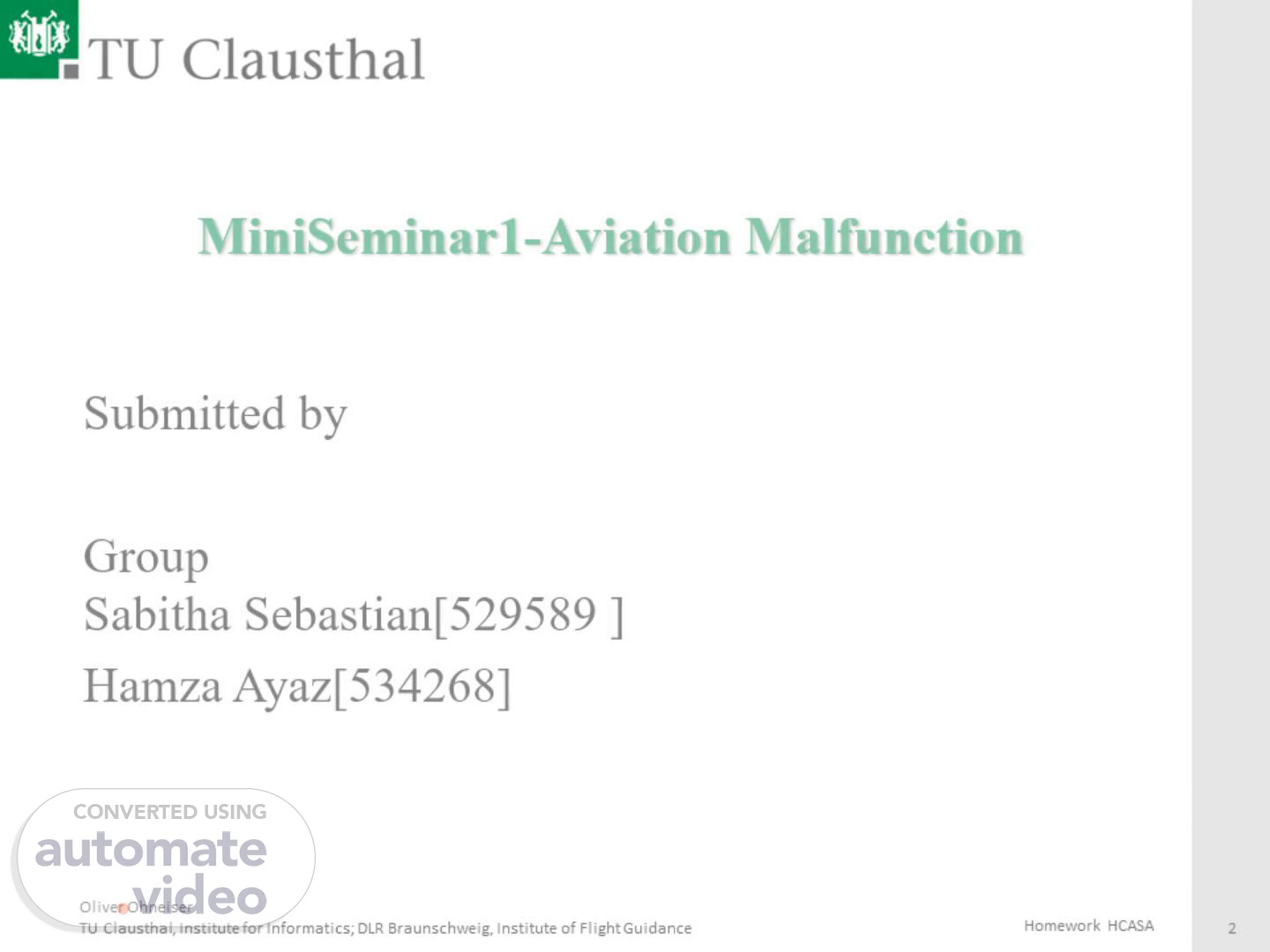
MiniSeminar1-Aviation Malfunction
Scene 1 (0s)
[Audio] Today I am presenting Mini Seminar on Aviation Malfunction, and our findings are about Sriwijaya Air Flight 182 that occurred on January 9, 2021. This domestic flight from Jakarta to Pontianak ended in the Java Sea, claiming the lives of all 62 people on board..
Scene 2 (19s)
[Audio] The flight was carrying a total of 62 people, including 50 revenue passengers and 12 crew members. Departure was delayed due to monsoon rains, and the actual takeoff occurred at 14:36 local time. Tragically, all 62 people on board lost their lives in the Java Sea off the Thousand Islands. The main reason of this flight crash was issue in auto throttle and negligence of the pilot..
Scene 3 (46s)
[Audio] As for the detailed description after takeoff, the aircraft deviated off course, prompting queries from air traffic control (ATC) with no response. The auto throttle malfunctioned has started with the engagement of auto pilot, leading to a reduction in left engine thrust and a increasing right engine thrust lever. This resulted in an uncontrollable turn and a rapid nosedive..
Scene 4 (1m 12s)
[Audio] The pilot engaged the autopilot system after the flight take off. The complexity of the auto throttle system, which allows pilots to set speed and flight characteristics, played a crucial role. The thrust asymmetry problem, where one engine produces more thrust than the other, was identified as a key issue. Similar flight behavior was observed in other Boeing plane crashes, implicating the auto throttle malfunction. During the critical moments, the captain lowered the target altitude and entered it into autopilot. The auto throttle adjusted levers to maintain the intended airspeed, but the thrust asymmetry led to an uncontrollable left turn, initiating a nosedive. Unfortunately, there was a lack of response from the pilots during this crucial phase..
Scene 5 (2m 3s)
[Audio] The auto throttle is a crucial component of the aircraft's automation system, responsible for controlling engine thrust to maintain the desired airspeed set by the pilots. The term "auto throttle malfunction" refers to a failure in the system responsible for automatically adjusting engine thrust to maintain the desired airspeed. Such malfunctions can be caused by technical issues, sensor errors, or a breakdown in the interconnected systems that govern the aircraft's automation. Automation, encompassing control systems, information technology, and Air Traffic Control operations, played pivotal roles. The interconnected nature of aircraft systems heightened the potential for malfunctions, such as the suspected auto throttle malfunction in this case..
Scene 6 (2m 51s)
[Audio] The negligence of pilot and completely relying on the auto pilot and do not keep an eye on the different indicators lead to the incident. Human factor analysis underscored the need for rigorous maintenance and quality control, improvements in pilot training, and ongoing enhancements in safety procedures and technology..
Scene 7 (3m 13s)
[Audio] The failure mechanism was multifaceted. The left engine throttle lever moved back as intended, while the right lever appeared stuck. This imbalance contributed to the loss of balance, with maintenance logs indicating prior auto throttle system issues which was resolved four days prior to the crash..
Scene 8 (3m 37s)
[Audio] Automation, encompassing control systems, information technology, and Air Traffic Control operations, played pivotal roles. The interconnected nature of aircraft systems heightened the potential for malfunctions, such as the suspected auto throttle malfunction in this case..
Scene 9 (3m 54s)
[Audio] Human factor analysis underscored the need for rigorous maintenance and quality control, improvements in pilot training, and ongoing enhancements in safety procedures and technology..
Scene 10 (4m 19s)
[Audio] In conclusion, the tragedy prompted an inspection of pilot training, emphasizing the importance of acknowledging the bravery of the crew during emergencies. Lessons learned encompassed enhanced reliability control, immediate correction during deviations, and the importance of effective training programs to minimize human error..
Scene 11 (4m 38s)
[Audio] Our takeaways include the necessity of regular maintenance, immediate correction during deviations, and the critical role of effective training programs in ensuring aviation safety..
Scene 12 (4m 54s)
[Audio] Here we have provided some references from where we have studied the incident and collected the data. Thank you...